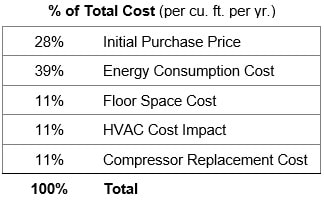Did you know that the initial purchase price is a relatively small part of the actual cost to own an ultra-low temperature freezer? That’s because the real cost of a ULT freezer is the sum of the purchase price, plus costs for energy, HVAC, cu. ft./m floor space and the usual compressor replacement. With the typical cascade-compressor freezer consuming the equivalent electric power of an average U.S. household, all that energy is rejected as heat in your building, which adds a substantial cost for your HVAC system.
What is your compressor-based ultra-low freezer really costing your organization?
Using manufacturers’ published energy use data at 16c/kWh electric costs, with typical cu. ft. floor space and compressor replacement cost estimates from independent sources, the table on the right estimates cost of ownership percentages per cubic foot of storage per year for a typical compressor-based ULT freezers.

Reduce Total Cost of Ownership by Thinking Strategically
Considering that the initial purchase price of -80°C ultra low temperature freezers accounts for less than a third of ULT storage cost, you can see how energy consumption and operating costs have a surprising impact on lowering overall life cycle cost. Of course, this is counter to the traditional way of thinking about buying ultra-low temperature freezers. More research organizations are now looking at their ULT freezer purchases strategically and replacing traditional freezer models with Stirling Ultracold units such as the 3.7 cu. ft./105 L Model SU105UE freezer, or the SU780XLE upright ultra-low temperature freezers. Using less than a third the energy, the SU780XLE can lower total cost of ownership by up to 40%—even with a higher initial purchase price. In fact, even a free cascade-compressor ULT freezer can cost more to own than the SU780XLE!
In fact, even a free cascade-compressor ULT freezer typically costs more to own than the SU780UE!
Our -20°C to -86°C ultra low temperature freezers are designed to deliver exceptional performance, maximize storage capacity, and leave a minimal footprint.








